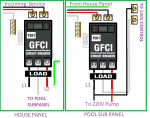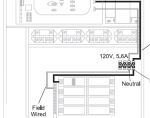Breakers: Siemens 40A GFCI at House Panel & 20 A GFCI at Hayward PL Subpanel
Current Wiring:

Does this look right? Specifically, with regard to the neutral path:
House Panel: Incoming Service Neutral - House Panel Neutral Bar - Pigtail to GFCI-Load Neutral Out to chlorinator subpanel (connected direct to GFCI )
Pool Sub Panel: Load Neutral out From House Panel - Into Subpanel Neutral Bar- Pigtail to GFCI-Load Neutral to 120 Volt Chlorinator Control (connected direct to GFCI )
Thank you
Current Wiring:

Does this look right? Specifically, with regard to the neutral path:
House Panel: Incoming Service Neutral - House Panel Neutral Bar - Pigtail to GFCI-Load Neutral Out to chlorinator subpanel (connected direct to GFCI )
Pool Sub Panel: Load Neutral out From House Panel - Into Subpanel Neutral Bar- Pigtail to GFCI-Load Neutral to 120 Volt Chlorinator Control (connected direct to GFCI )
Thank you



